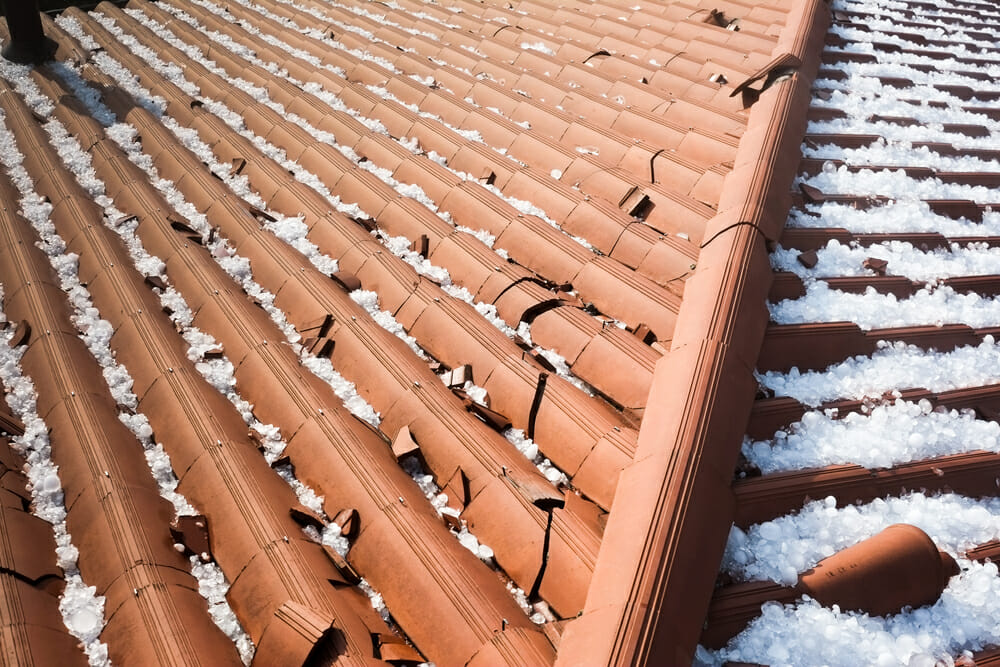We settle large-loss hail damage insurance claims

HAIL DAMAGE LOSS
Trust ICRS public adjusters to settle your hail property damage insurance claim
When hail has devastated your property, call ICRS public adjusters to settle your hail claim. We can help you put the pieces back together.
- Commercial Property Hail Claims
- Multi-Family Property Hail Claims
- High-Value Homes & Real Estate Hail Claims
Public Adjuster for Hail Claims
Hail Damage Insurance Claims
Maximizing Your Hail Damage Insurance Claim with ICRS
When dealing with commercial or multifamily hail damage building and roof insurance claims, hiring ICRS Public Insurance Adjusters can make a significant difference in the outcome of your claim. This web page outlines the benefits of hiring ICRS Public Insurance Adjusters, the ideal time to do so, and the importance of proper representation throughout the claim process.
When to Hire ICRS Public Insurance Adjusters
The best time to hire ICRS Public Insurance Adjusters is at the beginning of the claim process. Doing so ensures that your claim is documented properly, helping you get a fair and prompt settlement.
Benefits of Hiring ICRS Public Insurance Adjusters
- Time and Money Savings
- Ensuring Proper Interpretation of Policy Language
- Access to Professional Opinions and Resources
- Support in Navigating Bad-Faith Insurance Practices
- Streamlined Claim Process and Documentation
- Skilled Negotiation for Large Loss Insurance Claims
Free Hail Insurance Claim Evaluation
ICRS offers a complimentary hail report, policy review, and building inspection to help you assess the potential damage and validity of your claim. Click here to get started.
Leveling the Playing Field with Your Insurance Company's Adjuster
By hiring ICRS Public Insurance Adjusters, you ensure that you have experienced professionals working exclusively in your best interests, leveling the playing field against the insurance company’s adjuster.
We hold HAAG Commercial Roof Inspector and IICRC WRT certifications in addition to public adjuster licenses in multiple states.
ICRS routinely settles complex multi-million dollar hail claims. If you own or manage an HOA, Multifamily apartment complex, food plant, storage facility, high-value home, or other commercial property, you’re no stranger to risk management. When your real estate asset suffers a hail damage insurance claim, managing risk and knowing your policyholder rights is critical to getting the fair and prompt settlement you deserve.
Large Commercial and Multifamily hail damage insurance claims can be complex, time-consuming, frustrating, and expensive if you don’t have professional guidance and representation. Know your rights and know your settlement options.
You wouldn’t hire the I.R.S. to prepare your tax returns so why allow your insurer to prepare your insurance claim?
Non-Litigious Approach to Settling Insurance Claims
ICRS takes a non-litigious approach to settling insurance claims, helping commercial and multifamily policyholders receive fair settlements while avoiding unnecessary litigation and appraisals.
Re-opening and Supplementing Underpaid Claims
If you are dissatisfied with your insurer’s settlement offer, ICRS can re-open and supplement your claim to help you receive the fair and prompt settlement you deserve.
Hail Damage Claims
Reasons why insurers deny or underpay insurance claims for hail damage
Reason 1: Lack of documentation
Reason 2: Poorly Maintained Roofs
Reason 3: Unclear policy language
Don’t let this happen to you! Take action now and protect your business. To ensure that your roof hail claim is not denied or underpaid, it is important to have a detailed record of all roof maintenance and repairs, including photos, dates, and descriptions. Additionally, it is important to thoroughly read and understand the language of your insurance policy to ensure that you are aware of any exclusions or limitations that may apply.
Numerous factors affect how a roof covering responds to hail events. Some of these include the roof covering’s age, type, quality, condition, and supporting material as well as variable storm attributes such as hail density, wind direction, and angle of impact.
What are common reasons why insurers deny or underpay hail and wind roof insurance claims?
There are several common reasons why insurers may deny or underpay hail and wind roof insurance claims:
- Damage not meeting the deductible: Many insurance policies have a deductible that must be met before the insurance company will pay for any damages. If the cost of the repairs is less than the deductible, the insurance company will not pay out the claim.
- Pre-existing damage: Insurance companies may deny claims for damage that was present on the roof prior to the storm. Policyholders need to have a clear understanding of the condition of their roof prior to filing a claim.
- Failure to maintain the roof: Insurance companies may also deny claims if the Policyholder has not properly maintained the roof. This could include failing to repair leaks or replacing damaged shingles.
- Age of the roof: Insurance policies may have restrictions on coverage for older roofs. If the roof is past a certain age, the insurance company may only pay for a partial replacement, rather than a full replacement.
- Dispute over the cause of the damage: Insurance companies may dispute the cause of the damage, especially if there were other factors at play, such as poor installation, deferred maintenance, improper installation, or inadequate ventilation.
- Incomplete or inadequate documentation: Insurers require detailed documentation of the damage, including photographs and repair estimates, to support the claim. Failure to provide sufficient documentation can result in a denial or underpayment of the claim.
It is important for home and business owners to review their insurance policies carefully and to work with an experienced contractor to ensure that all necessary repairs are documented and completed to the insurer’s satisfaction.
- Impact tests and field observations have shown that for laminated, glass-fiber reinforced asphalt shingles, hailstones striking perpendicular to the roof surface must be frozen solid and 1 -1/4 inch in diameter or larger before bruises (fractures in the reinforcement mat) and punctures are likely to occur.
- Hail impacts on a TPO roof system are characterized by tears and punctures or fractures of the single-ply membrane.
- Many roofing tiles are designed with a longitudinal interlock to allow proper water shedding in order to match the current surface elevation. The high kinetic energy of the hail impact on the lower corner of the roof tile can cause a point load break, or crack at the over lock corners. This is not a manufacturing defect of the product, but a point-loading impact that has occurred in a concentrated area.
- Polymer-modified bitumen membranes are composed of fiberglass and/or polyester reinforcement, and their top surfaces are protected by surfacing such as factory embedded granules, factory-bonded foils or field-applied coatings. Hailstones of sufficient size and hardness can puncture, tear or bruise a polymer modified bitumen membrane where they strike and reduce the membrane’s weatherproofing capability. A roof system’s expected service life can be reduced when hail disrupts the membrane’s protective surfacing and exposes its coating bitumen.
- Lastly, it is important to document all hail damage and file your claim as soon as possible.
When filing your commercial or multifamily building hail damage insurance claim, Policyholders need the evidence necessary to support all damages. Insurance Claim Recovery Support helps policyholders document damages and negotiate the insurance policy benefits they have paid for.
HAIL LOSS INSURANCE CLAIMS
How to Prepare for Hail Damage
- Before the Storm
• Trim tree branches so they don’t rub on the roof;
• Maintain roof per manufacturer recommendations and contractor repair recommendations;
• Remove debris from your roof, gutters and downspouts;
• Get your roof inspected prior to storm season. A little problem can turn into a BIG PROBLEM;
• Place any items from outside indoors. Small Items have a chance to fly around in high winds and you want to protect as many items as possible;
• Take advantage of our complimentary Risk-Free building inspection before storm season begins.
- During the Storm
• Close all windows and cover them up. You don’t want glass flying in.
• Stay indoors, away from skylights and doors.
• Hailstorms can be a warning sign for tornadoes. If the sky is getting dark and you start to hear a loud roar, take shelter in case a tornado is on its way.
- After the Storm
• Check property for potential direct hail and/or wind damage;
– Missing shingles, indentations in roof materials;
– Broken windows or siding;
– Dents in gutters, downspouts and air conditioning units;
– Water intrusion to interior.
• Indications of collateral damage
– Damage to trees, fences, landscaping and vehicle dents.
• Take pictures of all damages.
• Contact your insurer or insurance agent and put them on notice you intend to file a hail insurance claim.
• MITIGATE DAMAGES as soon as possible.
• Keep records of mitigation and clean up expenses.
Years Experience
Claims Settled
Hours Worked
Average Claim Amount
No Recovery, No Fee Offer
Get a complimentary consultation on your hail damage insurance claim. We are public insurance adjusters who work for policyholders, not the insurance company. If you choose to hire us, we work on contingency. No recovery, no fee. Our hail insurance claim process is proven and streamlined. We also value your privacy. We do not sell, trade, or rent your personal information to others.
Need immediate hail damage insurance claim help?
TESTIMONIALS
What Client Says About ICRS
It pays to know ICRS – “747% Higher Payments with a Public Adjuster for Claims related to a 2005 Hurricane”
Frequently Asked Questions
What is a public adjuster and what do they do?
When should I hire a public adjuster?
How are public adjusters compensated?
How do public adjusters differ from insurance company adjusters?
Do I need a public adjuster if I already have an insurance agent or broker?









